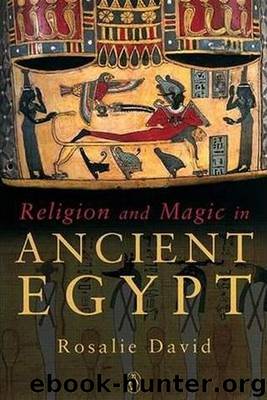Religion and Magic in Ancient Egypt by Rosalie David

Author:Rosalie David
Language: eng
Format: epub
ISBN: 9780141941387
Publisher: Penguin Books Ltd
Published: 2009-09-07T16:00:00+00:00
THE ROYAL FAMILY AT AMARNA
There has been speculation that Akhenaten’s cult grew out of his father’s own policy of identification with the sun’s disc and his personal deification; in fact, the cult may have represented the culmination of Amenhotep III’s own ideas. He was deified and worshipped as a god while still alive, and reliefs in his temple at Soleb in Nubia represent him performing the cult to his own deified self. It has also been argued that there is convincing circumstantial evidence that Amenhotep III spent his final years at Amarna, perhaps providing theological motivation for Akhenaten’s own actions.35
Akhenaten and Nefertiti lived at Amarna with their six daughters but the marriage apparently produced no sons. Their second daughter, Maketaten, died shortly after Year 12 of the reign, and soon after this, Nefertiti no longer features in the Amarna inscriptions. Death or banishment (perhaps because her opinions about the course of the religious revolution may have differed from those of her husband) have been suggested as explanations for her disappearance. However, between Years 13 and 15 of the reign, the eldest daughter Meritaten apparently replaced Nefertiti as her father’s consort. The custom of the king marrying his own daughter was not unique to Akhenaten, although it was far less common than the union between the royal heir and the Great Royal Daughter. Akhenaten may have entered into this relationship to ensure that no other external claimant attempted to marry the royal heiress (there was probably no royal brother to wed her), but it is most likely that his main aim was to try to beget a male heir with a new wife. However, the young queen apparently only gave birth to a daughter, Meritaten-tasherit, who survived briefly.
Meritaten’s name was subsequently associated with that of the royal relative whom Akhenaten appears to have taken as his co-regent in Year 13 of his reign. Details of Smenkhkare’s origins and life remain obscure. Apart from a suggestion that Smenkhkare was in fact a re-named Nefertiti36 (Smenkhkare was given one of the names of Nefertiti, and also the title ‘Beloved of Akhenaten’), it is generally assumed that both Smenkhkare and Tutankhaten were closely related royal princes. They may have been Akhenaten’s sons by a secondary wife, but it is perhaps more probable that their father was Amenhotep III, and their mother was either Queen Tiye (unlikely because of her age), or Sitamun (the daughter of Amenhotep III and Tiye who became her father’s wife),37 or another secondary wife. Marriage to Meritaten would have consolidated Smenkhkare’s claim to the throne, but she probably died before him and may have been buried at Thebes, although her tomb has never been found. When Meritaten became Smenkhkare’s wife, it is possible that Akhenaten married his third daughter, Ankhesenpaaten, and fathered another short-lived daughter, Ankhesenpaaten-Sherit. Eventually, Ankhesenpaaten became the wife of Tutankhaten (Tutankhamun) when he ascended the throne.
Only one known date of Smenkhkare’s reign survives, in a hieratic graffito in the Theban tomb of the official Pere. This gives a regnal date of Year 3, and indicates that Amun’s cult was already being reinstated.
Download
This site does not store any files on its server. We only index and link to content provided by other sites. Please contact the content providers to delete copyright contents if any and email us, we'll remove relevant links or contents immediately.
| Buddhism | Christianity |
| Ethnic & Tribal | General |
| Hinduism | Islam |
| Judaism | New Age, Mythology & Occult |
| Religion, Politics & State |
Cecilia; Or, Memoirs of an Heiress — Volume 1 by Fanny Burney(31361)
Cecilia; Or, Memoirs of an Heiress — Volume 3 by Fanny Burney(30958)
Cecilia; Or, Memoirs of an Heiress — Volume 2 by Fanny Burney(30915)
The Secret History by Donna Tartt(16693)
Sapiens: A Brief History of Humankind by Yuval Noah Harari(13100)
Leonardo da Vinci by Walter Isaacson(11938)
The Radium Girls by Kate Moore(10935)
Sapiens by Yuval Noah Harari(4567)
How Democracies Die by Steven Levitsky & Daniel Ziblatt(4436)
The Wind in My Hair by Masih Alinejad(4435)
Homo Deus: A Brief History of Tomorrow by Yuval Noah Harari(4301)
Endurance: Shackleton's Incredible Voyage by Alfred Lansing(3863)
The Silk Roads by Peter Frankopan(3804)
Man's Search for Meaning by Viktor Frankl(3662)
Millionaire: The Philanderer, Gambler, and Duelist Who Invented Modern Finance by Janet Gleeson(3585)
The Rape of Nanking by Iris Chang(3537)
Hitler in Los Angeles by Steven J. Ross(3456)
The Motorcycle Diaries by Ernesto Che Guevara(3353)
Joan of Arc by Mary Gordon(3276)
